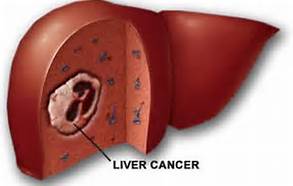Liver Cancer

|
even if it is not all you want.” Elbert Hubbard |
Liver cancer is a cancer arising from the liver. It is also known as primary liver cancer or hepatoma. The liver is made up of different cell types: liver cells (80%), bile ducts, blood vessels and fat-storing cells. The majority of primary liver cancers (over 90%-95%) arise from liver cells.
When patients or physicians speak of liver cancer they are often referring to cancer that has spread to the liver, having originated in other organs such as the colon, stomach, pancreas, breast and lung. More specifically, this type of liver cancer is called metastatic liver cancer or secondary liver cancer. This is a much more common problem around the world than primary liver cancer and frequently leads to confusion, because the term liver cancer actually can refer to either metastatic liver cancer or hepatocellular cancer. The subject of this page is hepatocellular carcinoma, herein referred to as just liver cancer.
Liver cancer is the third most common cancer in the world. A deadly cancer, liver cancer will kill almost all patients who have it within a year. In 2000, it was estimated that there were about 564,000 new cases of liver cancer worldwide, and a similar number of patients died as a result of this disease. About three-quarters of the cases of liver cancer are found in Southeast Asia. Liver cancer is also very common in sub-Saharan Africa.
The initial symptoms of liver cancer are variable. It is becoming much more common for patients to be identified by screening people at high risk for the cancer and finding the cancer before there are any symptoms at all. There are no specific symptoms of liver cancer, and in fact, the earliest signs are usually subtle and can be mistaken for simple worsening of cirrhosis and liver function. Abdominal pain is uncommon with liver cancer and usually signifies a very large tumor or widespread involvement of the liver. Unexplained weight loss or unexplained fevers are warning signs of liver cancer in patients with cirrhosis. A common initial presentation of liver cancer in a patient with compensated cirrhosis is the sudden onset of a complication. For example, the sudden appearance of ascites, jaundice or muscle wasting without causative factors suggests the possibility of liver cancer. Cancer can invade and block the portal vein. When this happens, the blood will travel paths of less resistance, such as through esophageal veins. This causes increased pressure in these veins, which results in dilated veins called esophageal varices. The patient then is at risk for hemorrhage from the rupture of the varices into the gastrointestinal tract. Rarely, the cancer itself can rupture and bleed into the abdominal cavity, resulting in bloody ascites.











